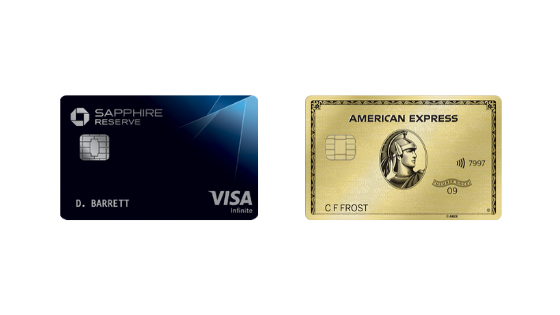At least five times a week, I get asked from friends and readers which is the best credit card to get. While I’ve gotten better at generating an answer to this quickly, it pretty much all boils down to a two-part response:
“It depends on where you spend the most money.”
And…
“Those serious about earning points/miles really need a minimum of two cards to maximize benefits.”
What I’ve learned from this common exchange is that the most beneficial course of action for 95% of people is to utilize a 2-card strategy. In fact, it’s pretty hard to think of anyone that wouldn’t benefit form using two cards in unison.
While it would be nice if there was a single card that was hands-down the best, that’s not the reality. For one, there’s no card that maximizes all earning categories. Credit card companies have a specific consumer in mind when they’re designing their card benefits and since all consumers are different, there needs to be multiple card variations. Second, no credit card issuer has a deal with every airline or hotel chain, so relying on a single card will never give you all the options needed to transfer your points to the best possible travel partner.
That’s why I think the 2-card strategy is so great. Because it’s simple enough to manage easily, but complex enough to maximize benefits while allowing enough nuance to create the perfect combo regardless of your personal needs.
Putting Together A 2-Card Strategy
Since there is no single best card, when I’m working with a client, my goal is always to understand which categories they spend the most money in and optimize those first. After choosing the card that fits the bill, then I choose a card that’s complementary to the first.
In my mind, a complementary card is one has bonus earning categories that are not covered by the first card and is likely with a different issuer. That way, there are more opportunities to earn points for purchases and more travel partners in which points could be transferred to. In most cases, this means 1 card from Chase and 1 from American Express.
The 1-2 punch of owning an Amex card and Chase card together is almost always the best combination for anyone seeking to earn and use points, but there is still the question of which card from each issuer is right for you. Fortunately, there are a few pairings that I would consider to be tried-and-true staples. I’ll cover all three below as well as the pros/cons of each and which you should choose based on your needs.
Pairing #1 – Chase Ink Business Preferred and Amex Personal Gold Card

This pairing is perfect for the business owner who wants a powerful combo to match their personal and business spending. With only a total annual fee of $345 between both cards, it’s possible to earn 4x points on dining and groceries and 3x points on travel (including tolls), postage, phone service, and online advertising. Not to mention, the Chase Ink Business Preferred card has one of the highest sign-up bonuses on the market at 80k points.
Sign-Up Bonus Potential (both cards combined): 130k
Pros: Good sign-up bonus, reasonable annual fees, most earning categories have solid earning rates.
Cons: No airport lounge access and only available to business owners.
Pairing #2 – Chase Sapphire Reserve and Amex Personal Gold Card

This is one of my favorite pairings for those that travel at least a couple times a year and want good travel benefits in addition to solid point earning opportunities. In addition to 4x points on dining and groceries, this combo also earns 3x points on travel. Additional traveler benefits include an automatic $300 credit towards travel each year, Priority Pass lounge access, and a free TSA pre-check or Global Entry membership once every five years. If you can capitalize on all these benefits, it’s a no-brainer.
Sign-Up Bonus Potential (both cards combined): 100k
Pros: Lounge access, free TSA pre-check/Global Entry credit, good travel credits.
Cons: Average sign-up bonus and higher annual fees ($800).
Pairing #3 – Chase Sapphire Preferred and Amex Personal Gold Card

This is a great entry-level pairing for those that don’t travel often or are sensitive about annual fees. If you aren’t concerned with travel perks or lounge access, this combo can still give you 4x points on dining and groceries plus 2x points on travel which should still earn a substantial amount of points. If you want to get started off right without a large financial commitment, then this is the perfect way to go.
Sign-Up Bonus Potential (both cards combined): 110k
Pros: low annual fee.
Cons: No lounge access, average earning on most travel, few perks.
But What About Other American Express Cards?
You may have noticed in the pairings above that I didn’t mention any Amex cards other than the personal gold card. The main reason for this is because it is the most complementary to the Chase credit cards currently available, and in my opinion, the best value Amex card. While there is certainly a time and place to have an American Express Platinum card, I believe that unless you fly quite often, this card won’t offer the best value.
Instead, I see most other cards as great additions to the core pairings above if you’d like more diversification in your card portfolio.
Conclusion
Even though building a great point earning and redeeming strategy isn’t as simple as picking just one credit card, it still doesn’t have to be complicated. Almost anyone can employ the 2-card strategy and still win by choosing a solid pairing that gives them maximum opportunities and value. By selecting one of the options above, you can get started right away with confidence.


